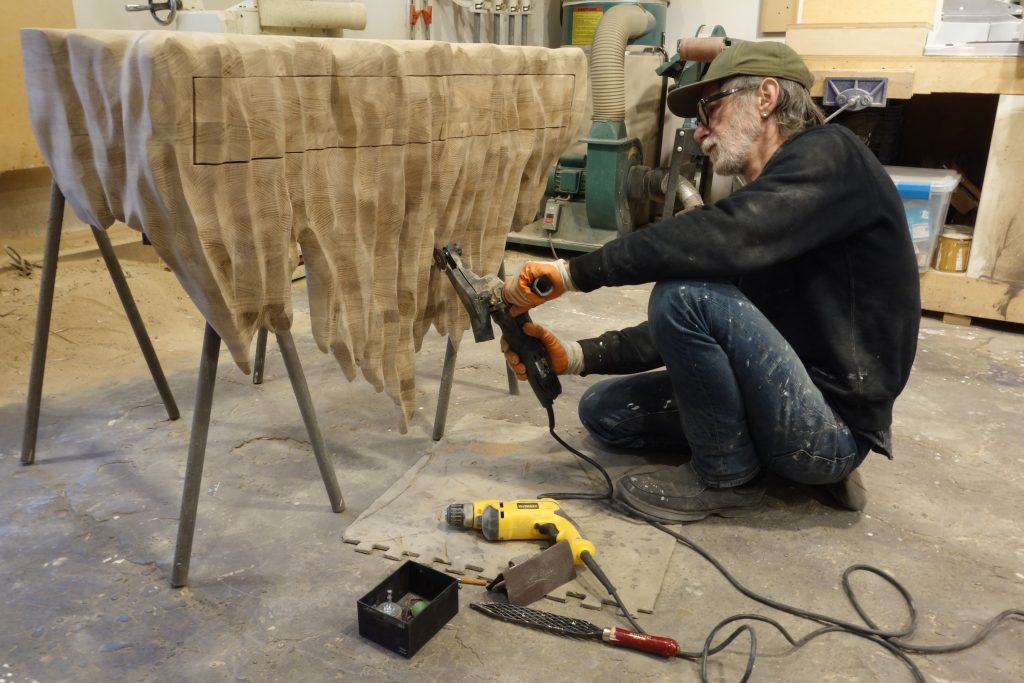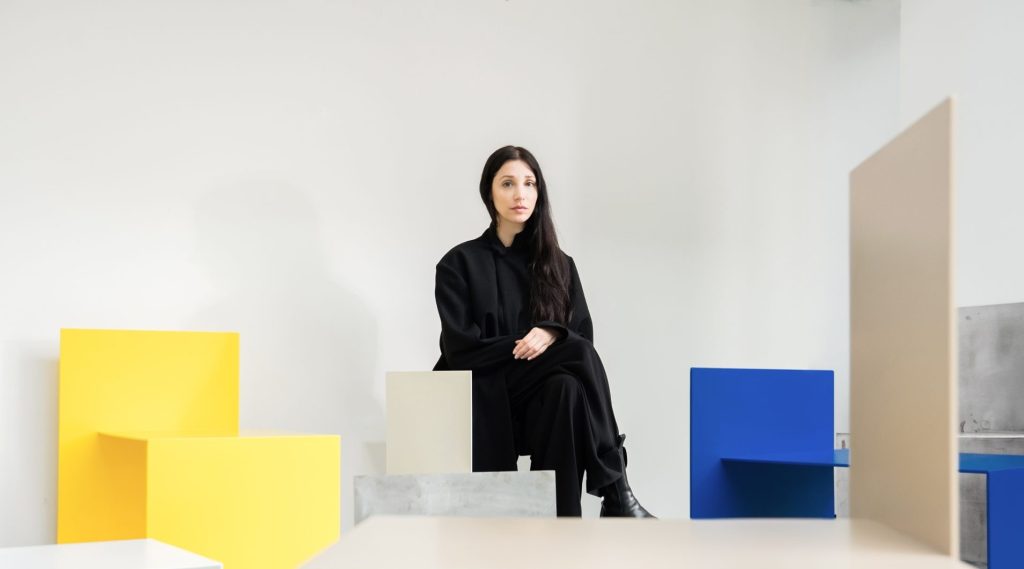
Ghaya Bin Mesmar X Mermelada Estudio: Dialogues of Safeefah
“…[Ghaya] likes to work on every little detail, while we love to research a good story that we can tell through our objects. Together we found the perfect typology to work on – an Emirati seating system that few designers have worked on before.”
– Mermelada Estudio & Ghaya Bin Mesmar
View Ghaya Bin Mesmar & Mermelada Estudio’s works, including the “Safeefah Chair” collection
The Irthi Contemporary Crafts Council initiative “Crafts Dialogue” seeks to create collaborative relationships between artists, designers, and artisans, merging the artistic languages of different countries to develop new approaches to craft and design. Alongside artisans from the Bidwa Social Development Programme, pairs of international and Emirati designers have worked together to produce a series of collections which fuse Emirati and European design elements, illustrating the outcomes of creative dialogues between cultures and countries.
As part of this initiative, Emirati designer Ghaya Bin Mesmar and Barcelona-based design studio Mermelada Estudio (founded by Laura Blasco, Juanmi Juárez, and Alex Estévez) have brought together their approaches to design in order to create a collection of chairs which reinterprets Safeefah (palm frond weaving). With experience in visual communication and industrial design, respectively, the designers experimented with form, material, and technique to explore the dialogues that could be created and communicated through craft. Their collection of “Safeefah” chairs is based on traditional areesh houses – desert structures made of palm. The ultimate, conical shape of the chairs creates a semi-enclosed, private, and protected space resembling these houses. The designers’ experiments with form, dye, and weaving speak to their shared creative exploration, producing a collection of pieces which blur cultural boundaries and merge the traditional with the contemporary.
In what way would you describe your two approaches to design?
Ghaya Bin Mesmar: The design approach to creating the Safeefah chairs came about from the process of understanding the craft of Safeefah and the behaviour of the khose palm fronds. Accordingly, experiments were made on dyeing, weaving, and folding the craft into various forms and functions; elevating Safeefah beyond the traditional and into the realm of contemporary furniture.
Mermelada Estudio: Our approach is based on reflection. Our projects can go from unique pieces to mass production, and every project has very specific needs – we always try to understand what these are, and how they can be met in the best possible way.
Since we were kids, the whole team has been fascinated by objects, constantly asking things like, ‘How was this produced?’, or ‘Why is it this shape?’. This curiosity brought us into the design world. What inspired us to create our design studio was the idea that you can tell stories – from the beautiful stories to the everyday – through objects.

How have you merged aspects of your design practices for this collaboration?
GBM: Coming from a graphic-design background. I was interested in approaching Safeefah from a graphic perspective. We wanted to come up with a new visual language for Safeefah. We wanted to explore and dye Safeefah using colours that have never been used before, and experiment with different techniques to achieve new patterns and textures.
ME: This collaboration has been very enriching – a perfect blend between two ways to approach design. Since the beginning we felt a strong creative connection with Ghaya and we were in constant dialogue with her. Ghaya thoroughly explored all of the possibilities for weaving and dyeing that Safeefah could offer – she likes to work on every little detail, while we love to research a good story that we can tell through our objects. Together we found the perfect typology to work on – an Emirati seating system that few designers have worked on before. There were no existing archetypes, which was exciting. We identified the story for this object and Ghaya worked on the details. The result is this unique chair collection.
As a collaborative initiative, what has been the most surprising aspect of your participation in “Crafts Dialogue”?
GBM: The most surprising aspect was working with khose as a material. It has a waxy surface and is very dry in comparison to other palm trees so we were not able to use every kind of dye. The different shades of the palm frond “khose” would create inconsistencies in colour during the dyeing process. Furthermore, different types of khose in different sizes would create different sizes of Safeefahs. This resulted in having to produce more Safeefah pieces to fit the grid of the chair, and having our artisans adjust the sizes of the existing Safeefahs.
ME: Through this experience we learned so much – about an area few people understand very deeply. Before this collaboration, for us, the UAE was a country we associated with the future, with energy, oil, and avant-garde architecture. It was really surprising to discover a country with a unique heritage of traditional crafts.
Can you describe how the process lead you to the final design of the “Safeefah” chair collection created for Irthi’s “Crafts Dialogue” initiative?
GBM: I worked closely with Mermelada Estudio during the research and concept stage. We were inspired by the majlis seating system. As we were conducting the research, we stumbled upon images of traditional areesh houses in the desert. One of the images showed a house blown down by the wind, which fascinated us and we wondered if this unique narrative can be turned into a seat. Once we settled on the form of the chairs, we started the experimentation process with Safeefah.
ME: We love to research other cultures to find traditional objects that we can use as a starting point to create new versions. There are lots of connections and similarities between East and West, but there are also differences in everyday actions such as sitting – a universal act which can be performed in almost infinite different ways. In the East, it’s common to sit at a lower height than in the West, and to do so in a more relaxed and carefree way. We were fascinated by this, so we wanted to create a chair that reflected the Emirati way of sitting, but was also a statement piece. When searching for the concept, we found a set of images of ephemeral desert architecture made in traditional Safeefah. One of these images showed how a house had been blown down by the wind and resembled a giant tilted cone. It had a majestic appearance that fascinated us and made us wonder if this visual language could be translated into a seat.
The results of this inspiration are two types of seats that respond to two ways of sitting, both covered with Safeefah that gives protection and some privacy. The cover was made by weaving palm in a contemporary way, placing a special emphasis on the mixing of colours.
How has the “Safeefah” chair collection allowed you to experiment with traditional and contemporary techniques, forms, and materials?
GBM: During the dyeing process, we experimented with different kinds of dyes, ranging from natural dyes to chemical-based dyes. We also studied different techniques to achieve the colours we wanted. It was also a learning curve for the artisans as they were also experimenting with dyes that they have never worked with before so it took some time to get the right blue shade. It was very much a trial-and-error process to achieve the required outcome.
As for experimenting in techniques, we used a different weaving technique to achieve a new pattern for the blue and beige chair.
ME: The collection allowed us to experiment with weaving techniques that were previously unknown to us, and which are rarely used to produce chairs. The Eastern way of sitting allowed us to research creating archetypes, and play with shapes that we would never otherwise explore on a chair.
Are there aspects of this collaboration that you will bring into your own practices? If so, what and how?
GBM: Through this collaboration, we came to understand khose as a material and the craft of Safeefah weaving. Since then, I have continued the research of developing Safeefah as a craft and explored further dyeing techniques. At Irthi, we are working with Dr. Sandra Piesik on another research-based project where we utilise date palm waste and extract fibres to create textiles.
ME: Yes! We are now very keen to keep exploring other cultures, their traditions and crafts. There is an ocean of possibilities to explore. Also, it was very enriching to collaborate with another designer and have a creative dialogue from different perspectives. This experience has motivated us to work on new projects and join forces with other creative people.
Bio
Ghaya Bin Mesmar
Ghaya Bin Mesmar received her Bachelor of Science in Visual Communication from the American University of Sharjah in 2012. Her passion is for anything print-related and typo/graphic. Literature, history, non-fiction and culture have been her main sources of inspiration. She has previously exhibited at Design House, Sikka Art Fair (2014), Emirati Expressions, Manarat Al Saadiyat (2015) and Tashkeel as part of Design Days Dubai (2012) and Made in Tashkeel (2014, 2015). Ghaya Bin Mesmar ‘s design projects encompass type design, editorial design and branding.
Mermelada Estudio
Mermelada is an industrial design studio founded by Laura Blasco, Juanmi Juárez and Alex Estévez. The three of them met in Barcelona after years of training in Design Schools in Spain, England and Italy, and set off on a creative journey brought together by their common aim of finding the extraordinary in the ordinary.
The media have described their work as a mix of wit and poetry and praised them for their unconventional look at objects that fill up our everyday lives. They strive to find excellence and achieve balance in each one of the projects where they have participated. They collaborate with renowned international brands such as Moroso, Kettal, BD Barcelona Design, Kvadrat, Fermob, and RS among others.
In 2012, the trio created Mermelada Editions, the outlet they use to design, manufacture, and distribute their innermost creations. This way, they share with the public limited and unique editions of their objects.
Their work has travelled the world in exhibitions, trade fairs, and conferences. Recently, Elle Decoration Spain has awarded the studio as best young Spanish designers of 2016.














